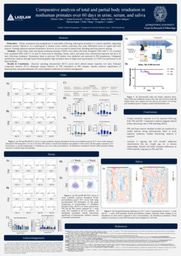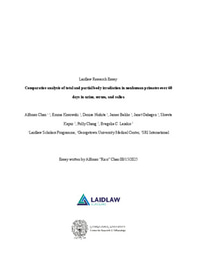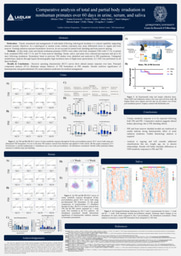Comparative analysis of total and partial body irradiation in nonhuman primates over 60 days in urine, serum, and saliva
Abstract:
Effective triage in response to acute radiation exposure events can often define the quality of patient outcomes. Exposed individuals may be rapidly triaged using biological assays that measure changes in cellular metabolic pathways. Modern biosignature assays for acute exposure are built upon idealistic total body models that assume ionizing radiation is indifferently distributed. However, most radiological or nuclear exposures occur in environments that induce shielding and complex bodily absorption patterns. My Laidlaw research project will utilize LC-MS data collected from partial body irradiated nonhuman primate serum, urine, and saliva to build upon previous studies. LC-MS data will be screened for known metabolites and analyzed in comparison to both non-irradiated and total body irradiated nonhuman primates.
Objective:
- Compare irradiated nonhuman primate samples to controls and identify metabolic biomarkers indicative of exposure.
- Evaluate previously accepted biomarkers under partial body irradiation model to enrich modern understanding of relevant physiology.
- Synthesize findings in a heatmap that will support future endeavors.
Background:
Bioassays are of particular interest as a response mechanism to nuclear threats and accidental radiation exposure risks. Previous studies have built robust collections of metabolomic biomarkers using total body irradiated nonhuman primates. While the works above have identified metabolites of interest, a realistic radiation dosage involves shielding effects and differential exposure patterns. Partial body irradiation is commonly believed to better reflect the influence of shielding and is therefore of particular interest in developing more accurate biomarkers.
Methodology:
The bulk of this project involves an arsenal of data analytics and statistical analyses to characterize samples of blood, saliva, and urine of partial body irradiated rhesus monkeys following a 60-day recovery period. After initial processing and deconvolution of protein mass spectrometry using Progenesis QI, data will be normalized to total protein levels and quantified utilizing a microBCA assay. Processed metabolomic data will be denoted in comparison to existing and newly acquired data from total body irradiated studies. Initial comparative analysis using the machine learning algorithm Random Forests in Python or R will generate multidimensional scaling plots of relevant molecular ions. Statistical significance of disparities between partial and total body will be evaluated under a one-way analysis of variance test; significant ions will be identified concerning metabolome databases. Following the classification of positively identified metabolites, additional algorithms will exclusively discern biomarkers of radiation exposure.
Potential Impact:
This project will inform future biomarker development and enhance correlation with radiation exposure conditions. Future works built upon this project's comparative analysis will inform the creation of clinically-applicable bioassays. Ultimately, my project will provide critical analysis that will guide future endeavors within the field of radiobiology.




Please sign in
If you are a registered user on Laidlaw Scholars Network, please sign in